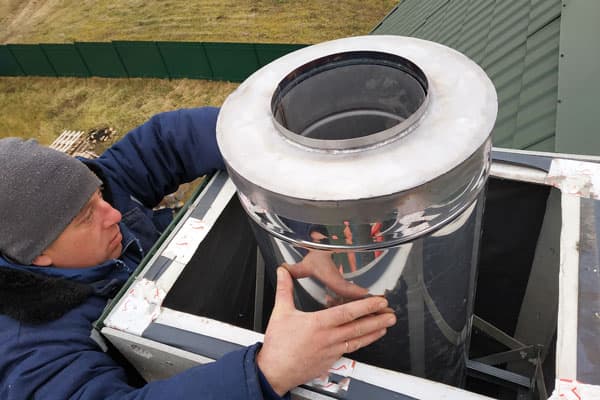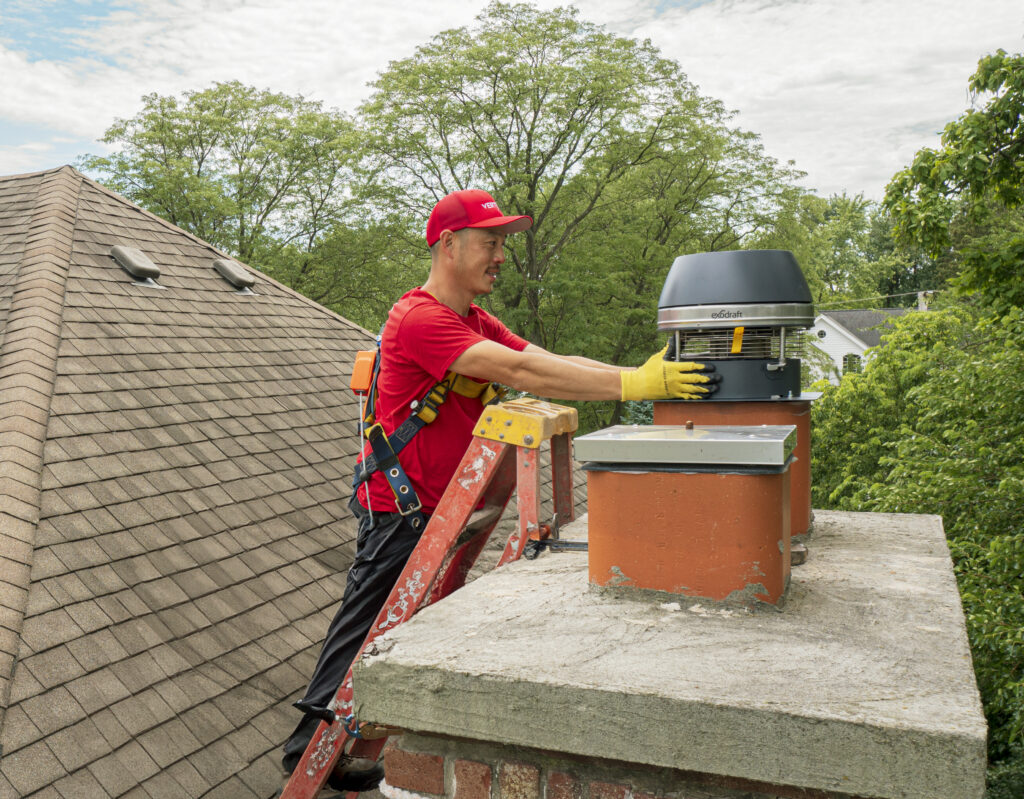
Many individuals believe that whatever is connected to the chimney stays connected to the chimney. That is only sometimes the case, though. First, think about how much venting your home's appliances require.
It is accurate to say that a chimney's vents help to remove smoke, gases, and other byproducts produced by a fire in the fireplace. Additionally, these vents aid in the gas evacuation from heating equipment like your furnace, boiler, and water heater.
Fuel, air, and ignition work together in gas-heating appliances to create combustion, which heats the air and water in your home. Similar to how a fireplace produces waste, so does this. Fireplaces and water heaters produce condensate, carbon monoxide, and other pollutants; thus, venting them out of your home is necessary.
When burning wood, layers of ash or creosote may amass inside your chimney, possibly leading to a blockage. An obstruction will impede the correct venting of your chimney. The fumes from your fuel oil cannot escape if you are also venting your gas or oil stove through the same chimney, and they will back up into your house and put you at risk of carbon monoxide poisoning.
The byproducts from the chimney are distinguishable from those from the furnace because they can be smelled and seen. The byproducts of the furnace and water heater are invisible and odorless. This is a key factor in why it's crucial to get your chimney cleaned and inspected yearly.

Things to Know for Chimney Ventilation
Many of us have yet to learn what our chimneys do or even how they work. Understanding the fundamentals of chimneys and chimney ventilation is crucial.
Chimney
The chimney projects outward from the peak of your house's roofline in a vertical stack. This ensures that smoke, gas, and other combustion-related byproducts can safely leave your house. Before leaving your house, a chimney may go through more areas of it. This is frequently observed in homes with chimneys on the first floor or not placed against an exterior wall.
As a general rule, it is preferable to build chimneys that are taller to reduce wind turbulence. The chimney's peak should ideally be directly above the roof's peak. The chimney will only work well if it extends below the highest point of the house envelope. This is due to the cooled air passing through a significant portion of the chimney area.
Bricks, mortar, or other types of masonry are frequently used in constructing chimneys. They may even be produced in factories utilizing stainless steel. Some factory-built chimneys have more intricate designs, such as siding or other roofing materials that go well with the house, a decorative chimney chase cover, or both.
The visible, outside part of your fireplace system that is exposed to the elements, is called the chimney. The chimney flue and appliance flue collar must have the same dimension. Your property may be at risk of experiencing a potentially disastrous chimney fire if your chimney is too large for the appliance. Oversized chimneys cause a greater draught.
Flue
The flue is a conduit for gases, smoke, and other combustion-related byproducts. Therefore, it is essential to shield other areas of the house from the heat produced by combustion byproducts, which are created when a fire is burned.
Today's homes typically have fireplaces with lined flues. Asbestos-cement pipe, cement, tiles, or metal are typically used to line these flues. However, the materials might eventually need relining because they will deteriorate over time. A cast-in-place or stainless steel liner must be used to repair a damaged flue liner in a chimney. This is done to prevent hot air, gas, embers, or sparks from passing through to ensure there are no gaps or holes.
Vent
Vents transport the combustion byproduct outside for appliances that operate at lower temperatures (those that use gas or oil). Vents may flow within the home or outside if they are shielded from the elements. Vents require some temperature protection; otherwise, their low-temperature combustion products might be too cold to vent adequately. This might lead to a risky buildup of combustible byproducts in your vent.

To release the byproducts, a vent's top must be exposed to the outside, but as long as the remainder of the vent is set up and covered appropriately, this exposure won't be a problem. In addition, a vent fan may occasionally be fitted to help push (or pull) low-temperature byproducts from the vent.
Vents are always manufactured. Since they cannot withstand the high temperature of wood combustion, they are not chimneys. However, if nothing else is venting via the chimney and is contained in a separate flue, some vents may pass through a chimney.
Type B vents are double-wall vent pipes manufactured specifically for gas venting. They are always constructed with an aluminum interior and a galvanized outside. As a result, there is little room between the walls for air. This affordable vent can be used as a connector or a vent.
Type L vents are designed to vent oil and can either be a connector or a vent. L vent availability is constrained because chimneys are still favored in the market over L vents. When pellets, maize, cherry pits, etc., are burned, the products are vented, and this is sometimes referred to as "bio-mass venting."
Technically, Pellet vents are also L vents. These vents must be set up inside a house or in a chase. Although they have stainless steel innards, their exteriors could be made of galvanized or black steel.
Why do Chimneys Need Vents?
The flue vent lining of the chimney must be in good functioning order whether or not you use your fireplace to ensure that moisture that has built up inside is removed and that there is good airflow and venting available. The chimney's main purpose is to do this. The Chimney Safety Institute of America estimates that around 10 cubic feet of air are required to replace one cubic foot of combusted natural gas with an acceptable amount of oxygen. A strong enough draught ensures that enough air is drawn in.
The best chimney lining material for oil, gas and wood-burning equipment is stainless steel. The liner is also a continuous piece of metal that ensures the safe ventilation of gases and smoke while removing extra moisture that could result in a leak. Additionally, it guards against corrosion or deterioration inside the chimney itself.
How Does Chimney Venting Work?
Ventilation can be accomplished in one of two ways: naturally or mechanically. While mechanical ventilation employs a fan to force the air up and out, natural ventilation relies on the buoyancy of hot air to rise and escape up the chimney.
Since the heat from the fire generates enough rising hot air to force the waste products up and out, natural ventilation is frequently used in fireplaces.
On the other hand, stoves typically utilize mechanical ventilation because they don't produce enough heat to generate a natural draught.
There must be a direct passage for the air to go for any ventilation to function efficiently. This means that the stovepipe or chimney must be tall and unobstructed. Regular chimney sweeps and inspections will help to keep your chimney clear of blockages.
The Benefits of Chimney Venting?
For your chimney and fireplace to work correctly, chimney venting is necessary, but that's not all. Venting has some other advantages outside just being a safety measure, like:
- Lowering energy expenses - An efficient fireplace or stove will burn less fuel and be more cost-effective, which can help you lower your energy expenditures.
- Odor avoidance - When combustion gases are not adequately vented, they might seep into the house and produce unpleasant aromas.
- Increasing the quality of the air within your home - By venting the combustion pollutants outside, you'll raise the standard of the air inside. This is crucial for households where there are asthmatic and allergic patients.
- A good vent can prevent moisture buildup in the chimney, which can result in water damage to the chimney.
- Increasing the lifespan of your chimney - You may increase the lifespan of your chimney or stove by routinely eliminating the waste products of combustion.
Maintaining your chimney's optimum ventilation should be an important aspect of your routine chimney maintenance. The chimney's venting system is essential for lowering the risk of carbon monoxide while allowing combustion products to depart the house.
To put it another way, chimney venting releases waste gases from combustion back into the atmosphere outside of your house. We hope this post has given you a better knowledge of how chimney venting functions and why it is a crucial component of any chimney care regimen.
Vertical has been in the chimney care business for over 35 years, and we have devoted our time and energy to bring safety to your home. We have spent all 35 years making sure we give our customers the best possible service. Take your chimney to a higher standard with Vertical and contact us today to get a free quote!
